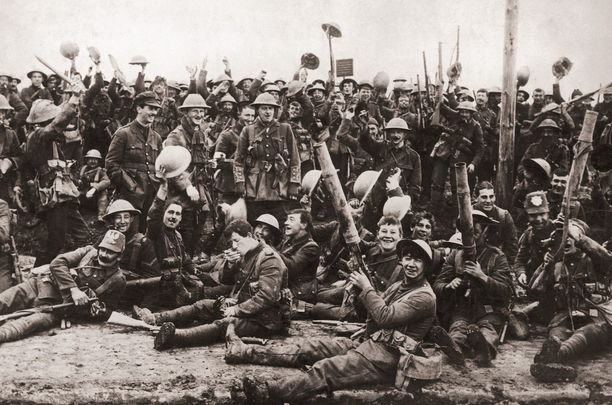During the rebellion at home, 488 Irish died. In the Hulluch gas attacks in France, during the First World War, 532 died.
“Even by the ghastly standards of the First World War the ordeal of the 16th (Irish) Division between April 27th and 29th, 1916, was awful.
“Those men who were not poisoned by chlorine gas were shelled, shot or bayoneted by the enemy, for whom this battle was equally bloody and futile. Heaps of bodies lay in the trenches or on the Irish lines,” wrote author Ronan McGreevy, for the Irish Times, back in 2016.
McGreevy, who is the author of the book "Wherever the Firing Line Extends: Ireland and the Western Front", wrote: “The 16th (Irish) Division was approved in September 1914, the same month that the Irish Republican Brotherhood sanctioned an armed rebellion against the British. During Easter Week 1916 both sets of armed Irishmen put their military acumen to the test, but only one would be celebrated and commemorated in the new Irish State.”
In late 1915, the division arrived in northern France and occupied an area of the front line where the British had suffered enormous losses that autumn during the Battle of Loos. When they arrived there, putrefied human remains were a “common sight.”
McGreevy wrote of the gas attack: “The German attack began at 4.35 am on April 27th, when its soldiers used machine guns and artillery against the Irish lines. The Germans knew the Irish would return fire: they would all approach the fire step to respond in kind, the front-line trenches packed with men.
“Ten minutes later, and to plan, the Germans released chlorine gas from 3,800 cylinders onto the Irish lines. A ‘dense cloud of black gas and smoke between us and the sun’ drifted across the Irish lines, according to Lieut Col Edward Bellingham, from Co Louth, the commanding officer of the 8th Royal Dublin Fusiliers.
He continued: “Under cover of the gas the German assault troops entered the fusiliers’ front-line trenches. The soldiers on both sides dreaded hand-to-hand combat most. Shells and machine-gun bullets at least had a degree of anonymity. The dead and wounded lay together often in a congealed mass of blood amid the choking gas, which gave everything a greenish pallor.”
In two days, 368 men of the 8th Royal Dublin Fusiliers were killed, wounded or missing.
“Farther north, on the front of the 7th Inniskilling Fusiliers, the Germans infiltrated the trenches. In the ensuing outburst of savage hand-to-hand combat, 66 men from the battalion were killed, but they held on and expelled the Germans.”
The Germans also suffered losses in the trench raids, with their own dean numbering in the hundreds.
McGreevy wrote of the last day of the attack on April 29th — also “the last, and bloodiest, day of the Easter Rising.”
“The chlorine gas was carried over to the Irish lines on a light breeze; it took 45 minutes to drift across no-man’s-land. British air reconnaissance noticed that the gas trail left a trail of dead vegetation ‘down to the last blade of grass,’” he writes.

Love Irish history? Share your favorite stories with other history buffs in the IrishCentral History Facebook group.
“On April 29th the 8th Royal Inniskilling Fusiliers replaced the 7th. It was their turn to face the Germans. Their 214 casualties included 62 dead.”
McGreevy also told of the tragic story of a man and his wife— Pte John Naylore of the Royal Dublin Fusiliers, who died on April 29th, and his wife Margaret who was shot that day in Dublin as she crossed Ringsend drawbridge. Margaret, who had gone out that day to get bread for her children, would leave three orphans when she died two days later.
He said the Battle of Hulluch “had been in vain.”
“Perhaps 1,000 men died on both sides, but the 16th (Irish) Division had held the line at a terrible price. More than 2,200 men were killed, wounded or missing.”
John Redmond, the leader of the Irish Parliamentary Party, was outraged by the rebellion, given what has occurred in France.
“Is it not an additional horror that on the very day when we hear that the men of the Dublin Fusiliers have been killed by Irishmen on the streets of Dublin we receive the news of how the men of the 16th Division – our own Irish Brigade, and of the same Dublin Fusiliers – had dashed forward and by their unconquerable bravery retaken the trenches that the Germans had won at Hulluch,” said Redmond.
The Germans hung a sign in front of the 8th Royal Munster Fusiliers two days after the attack. It read: “Irishmen! Heavy uproar in Ireland! English guns are firing at your wifes and children.”
Maj Larry Roche, second in command of the battalion, ordered the capture of the sign, which is now in the National Museum of Ireland at Collins Barracks in Dublin.
From May until August 1916, when it moved to Somme, the 16th (Irish) Division suffered 2,000 additional casualties.
The only reminder of the division’s presence in that part of France is a marble statue in the Church of St Martin de Noeux-les-Mines.
McGreevy wrote that the church was destroyed by German shell minutes before Notre Dame de Victoires was due to be placed on her pedestal. It had to be installed after the church was rebuilt, after the war.
The inscription reads: “To the memory of the officers, subalterns and soldiers of the 16th (Irish) Division who died on the field of battle or who died of wounds or disease contracted during the war in France in 1916 RIP.”
* "Wherever the Firing Line Extends: Ireland and the Western Front" by Ronan McGreevy is available here.
* Originally published in 2016, updated in April 2023.




Comments